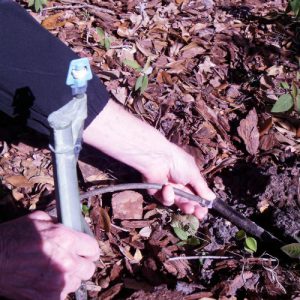There are so many options when choosing an irrigation system it can be confusing. Micro-irrigation is a great choice for many reasons. Not only is it easy to install, but it is also inexpensive and versatile. Micro-irrigation is also referred to as “low-volume” irrigation. It can be used for landscape plants, vegetable gardens and potted plants, but is not recommended for lawn irrigation.
Advantages of Micro-Irrigation
The advantages of micro-irrigation are numerous. Water-use savings are the most important. With micro-irrigation you decrease evaporation by watering a smaller portion of the soil and soaking the soil and roots of the plant. Another advantage is the lower flow rates. This means that micro-irrigation requires less energy to run than high-pressure systems and much less water is applied with each irrigation event. While a traditional sprinkler system uses as much as 400 gallons per hour (gph), micro-irrigation emitters have a maximum flow rate of 30 gph.
Micro-irrigation is also easily adaptable to changing topography. If your system is well managed, hilly terrain will not create runoff. Just like any irrigation system, if you follow proper maintenance practices your micro-irrigation system can help you save money on costly water bills.
Types of Systems
Different types of systems are available including, in-line drip tubing. This is a tube installed below the mulch where plants are placed close together and on a grid pattern (for example, when you use bedding plants and you install them every six inches throughout the landscape bed). Another type of system that can be used is drip emitters. Drip emitters are used for precise applications, such as potted plants or individual landscape plants. You can even use them to keep your bird baths full! Finally, micro-sprayers will cover the most area out of any of the systems and come in a variety of spray sizes and patterns. The type of system you choose depends on your needs, the design of your landscape and the type of plants installed. Micro-sprayers are ideal for mixed perennial beds or areas where you have plants growing that are not evenly spaced.

Whatever type of micro-irrigation system you choose, it is important to install a timer. Battery-operated timers are available from most manufacturers and are installed directly on the hose bib for easy use. You can also install micro-irrigation to run with your automatic sprinkler system. It must be installed in a separate zone because of differing run times and application rates. It is also possible to use a small pump and use harvested rainwater and a micro-irrigation system.
With so many options and versatility, micro-irrigation is a great option all types of landscapes. Micro-irrigation can improve plant health, reduce pests, disease, and weeds in landscape beds and edible gardens. For more information on micro-irrigation refer to UF/IFAS Fact Sheet AE524.
For more information, contact UF/IFAS Extension Polk County at (863) 519-1041 or visit us online at http://sfyl.ifas.ufl.edu/polk. The Plant Clinic is open Monday-Friday, 9:00 am-4:00 pm to answer your gardening and landscaping questions. Visit us in person, give us a call, or email us at polkmg@ifas.ufl.edu.
An Equal Opportunity Institution.
 0
0
